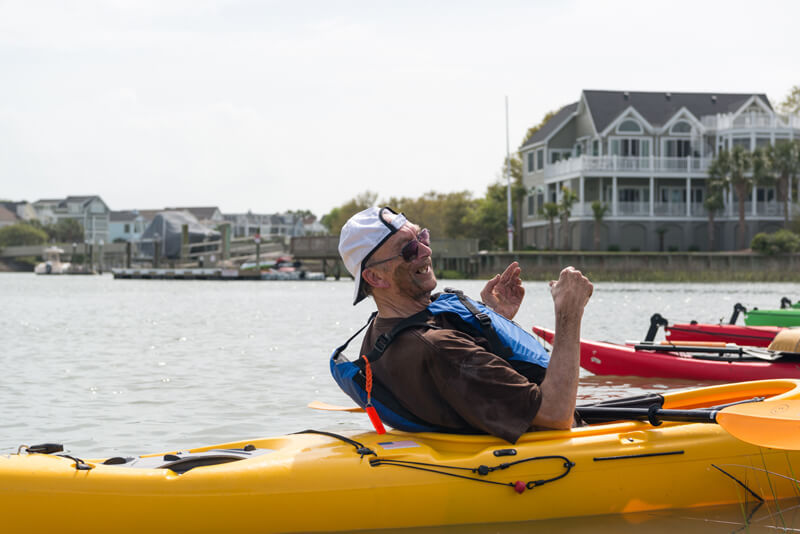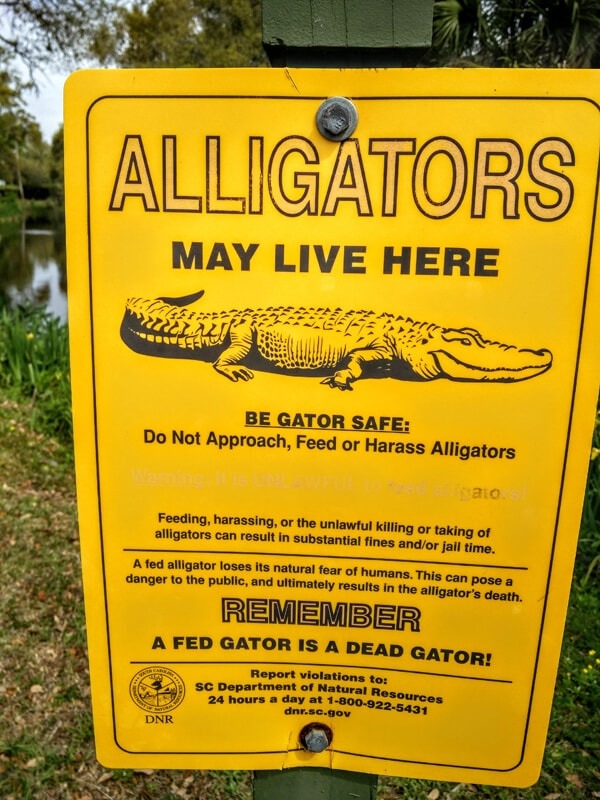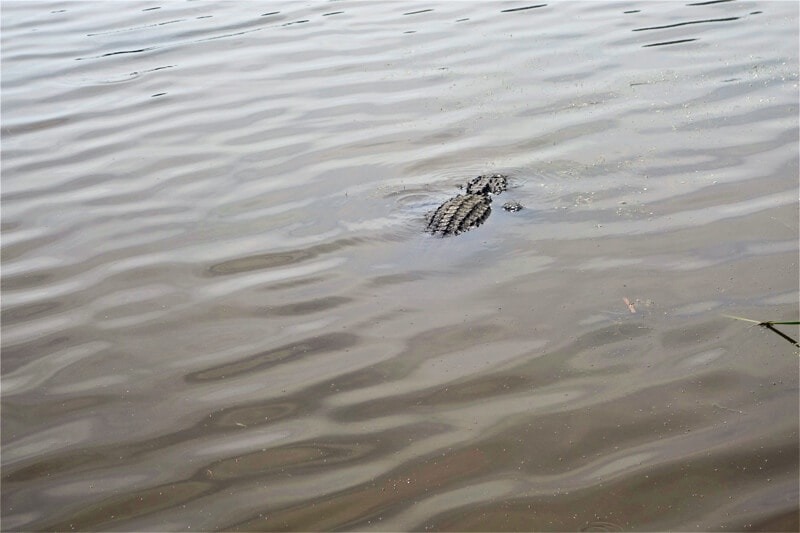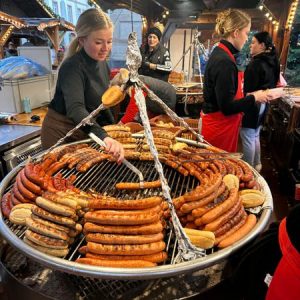As places to get a restorative face pack go it was hardly in the luxury spa bracket but Scott Depung gave it a five star rating so in went the kayak paddle and up came the mud. Well, strictly speaking, not just mud but pluff, which is mostly a mixture of decomposing vegetation, crabs and other marine life. It’s full of nitrates. Scott, whose outdoor life cannot be kind to hands, said he rubbed it into his to nourish the skin. So not to miss out I slapped it liberally on my cheeks.

The word pluff dates from the days of slavery in the marshy South Carolina Low Country. West Africans arriving with no English were understandably confused by the various pronunciations of ‘ough’. Pluff was so nutrient rich that sea island cotton farmers began ploughing it into their fields and plough somehow came to be pronounced as ‘rough’. It is the consistency, though hardly the smell, of melting chocolate. Besides its beneficial effect on complexions and crops it’s used to dye T-shirts. It may have even helped prolong the Civil War when Union soldiers blundered into it knee deep during a failed attempt to take the key port of Charleston by land.
According to Scott you could even eat it. My curiosity was aroused, though not sufficiently to induce me to try a mouthful.
Scott was our kayaking guide. He works for Coastal Expeditions, an operation staffed by biologists and ecologists. A true enthusiast for nature, he could happily spend all day on the water. We joined him at one of the company’s bases, a private dock on the Isle of Palms, not far from Charleston. Inevitably our first question was: would we encounter any alligators? They were certainly in evidence, basking by golf fairways, cooling off in lagoons, near our accommodation at the huge Wild Dunes Resort. Just that morning I’d seen a sign advising guests not to feed them, for fear they might get too familiar. “A fed gator is a dead gator”, it warned. Scott allayed any fears we might run into some reptilian version of Jaws. They much preferred fresh to brackish water.
 Before we launched, he went through his regular mantra: long (strokes), loose (grip), level (paddles), lever (push with the non pulling paddle). It was years since I had paddled a kayak. A black headed laughing gull guffawed at my pathetic initial attempts to manoeuvre. Immediately we left the dock we had to negotiate a tiny stretch of the Intracoastal Waterway, the mix of bays, inlets, rivers and canals that runs for 3000 miles from New England to Texas. We hugged the side as powerboats roared past. It was like driving a pedal car on the M1.
Before we launched, he went through his regular mantra: long (strokes), loose (grip), level (paddles), lever (push with the non pulling paddle). It was years since I had paddled a kayak. A black headed laughing gull guffawed at my pathetic initial attempts to manoeuvre. Immediately we left the dock we had to negotiate a tiny stretch of the Intracoastal Waterway, the mix of bays, inlets, rivers and canals that runs for 3000 miles from New England to Texas. We hugged the side as powerboats roared past. It was like driving a pedal car on the M1.
Safely in the tranquil water of an inlet we headed for a marsh of spartina alterniflora. Otherwise known as cord grass, this plant soaks up salt and exudes it. When the salt dries into crystals you can run your hand along it and get enough to season a barbecue, said Scott. It was here, with the bows of my kayak held firmly by the grass, that I scooped up some pluff from the bottom, perhaps less than two feet below the surface. It’s easy to see why people so often get stuck in this stuff. It’s sometimes called ‘pocket mud’. Because that’s how deep they can sink in.
Coastal Expeditions also run the ferry to Bull’s Island. If we had time, we should go there, urged Scott. We made the time. The 5000 acre island is part of Cape Romain National Wildlife Refuge. Because the refuge embraces a stretch of the mainland shore near Charleston, there is no local industry to pollute its waters. Bottlenose dolphins play alongside the ferry. Beyond the island jetty is a lush, pristine and very beautiful sanctuary, with 16 miles of hiking trails and seven miles of beaches where loggerhead turtles nest and relatively few visitors. On Boneyard Beach low tide reveals a bleached forest of trees, killed and stripped of their bark by the encroaching ocean. Red wolves, deer and bobcats live in the dense forest of live oaks, sabal palmettos, cedar, loblolly pines and magnolias. There are myriad species of resident or migrating birds, among them seven kinds of hawk, three different owls and the relatively uncommon wood stork. Coming unprepared, with no binoculars, I was limited to watching vultures circling and a squadron of pelicans patrolling the Atlantic shoreline.
 But I did encounter an alligator. It looked like a big one, its back glistening above the surface of Upper Summerhouse Pond in the island’s interior. I waited for it to heave itself out of the water, but in vain.
But I did encounter an alligator. It looked like a big one, its back glistening above the surface of Upper Summerhouse Pond in the island’s interior. I waited for it to heave itself out of the water, but in vain.
Meanwhile, what about that face pack? Did it take years off me? Can’t say I detected much impact but a younger companion claimed it made her skin feel wonderful. Hoping to get the full benefit I’d left it on after leaving the kayak dock. When I got back to Wild Dunes I’d temporarily forgotten the pluff was there. I must have looked a strange sight but if any other guests noticed they were far too polite to react. There was not so much as a discreet cough – or should that be cuff?
More information
Wild Dunes Resort will organise kayak tours for guests. The resort is a mix of hotel, rental and residential accommodation with an enormous white sand beachfront. It has six dining or snacking options, two golf courses (the Links Course was highly rated by fellow travellers), tennis courts, four swimming pools a spa, fitness centre and an excellent network of quiet paths and roads for running and exploring on hired bicycles.
Thanks to Diana Jarvis for the image of Roger with mud pack. All other images are his own.
Silver Travel Advisor recommends Frontier America.











